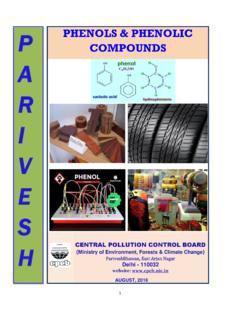Transcription of Ozone Reactions with Inorganic and Organic Compounds …
1 UNESCO EOLSSSAMPLE CHAPTERSOZONE SCIENCE AND TECHNOLOGY - Ozone Reactions with Inorganic and Organic Compounds in Water - Elina Portjanskaja Encyclopedia of Life Support Systems (EOLSS) Ozone Reactions with Inorganic AND Organic Compounds IN WATER Elina Portjanskaja Department of Chemical Engineering, Tallinn University of Technology Keywords: Metals, micropollutant, natural Organic matter, drinking water, wastewater, kinetics. Contents 1. Introduction 2. Oxidation of Inorganic Compounds Iron and Manganese Removal Halogens Removal Oxidation of Ammonia Nitrite Removal Hydrogen Sulfide Removal Removal of Chlorine Removal of Cyanide 3.
2 Oxidation of Organic Compounds Natural Organic Matter Oxidation of Organic Micropollutants Kinetics of Ozonation of Dissolved Organic Micropollutants Ozonation of Aliphatic Hydrocarbons and Halogenated Derivatives Ozonation of Alcohols, Ethers, Aldehydes, Carboxylic Acids Ozonation of Aromatic Compounds Ozonation of Phenols and Derivatives Ozonation of Amines and Derivatives Ozonation of Pesticides Ozonation of Pesticides Ozonation of Surfactants Ozonation of Dyes Ozonation of Endocrine Disruptors Summary and Conclusions Applications Landfill Leachates Partial Mineralization Textile Wastewaters Color Removal Other Applications 4.
3 Conclusion Glossary Bibliography Biographical Sketch Summary Ozone is a powerful oxidizing agent. Second only to fluorine in its oxidizing power, Ozone has many uses including but not limited to water purification, bleaching of UNESCO EOLSSSAMPLE CHAPTERSOZONE SCIENCE AND TECHNOLOGY - Ozone Reactions with Inorganic and Organic Compounds in Water - Elina Portjanskaja Encyclopedia of Life Support Systems (EOLSS) materials such as paper, synthetic fibers, Teflon, waxes, flour, and other products, treatment of wastes in industry, deodorization and sterilization.
4 Previously, chlorine products have been used for these purposes, but recent studies have shown that chlorine products may produce carcinogens such as trihalomethanes and chloramines. Ozone is a safe alternative to chlorine products which performs the same functions without the undesirable side effects; it is not harmful to the environment since it is made from oxygen and decomposes back into oxygen. The most common use of commercially produced Ozone is in treatment of water and wastewater such as sewage, wastewaters associated with pulp and paper mills, and waters polluted with pesticides.
5 These toxic wastewaters typically have high concentrations of organochlorine Compounds , phenols, amines, pesticides and are highly colored; these pollutants and colored Compounds are resistant to conventional methods of treatment. Studies have shown that Ozone is a viable alternative to the reducing of concentrations of these above-mentioned pollutants. The oxidative properties of Ozone are useful in the removal of soluble iron and manganese, the removal of unwanted colors, tastes, and odors, the decomplexing of bound heavy metals, the destruction of Inorganic components such as sulfides, cyanides, and nitrites, and the removal of suspended solids.
6 In these applications the Ozone Reactions are very rapid and contact time is short. Treatment of drinking water with Ozone also can disinfect the water by killing bacteria and inactivating viruses present in the water. 1. Introduction Water rapidly absorbs both natural and man-made substances generally making the water unsuitable for using prior to some form of treatment. Naturally occurring substances that may need to be reduced or removed in waters include iron, hardness and carbon dioxide. Substances originating from humans are becoming increasingly common in waters, and those requiring treatment include nitrates, pathogens and trace organics.
7 The objective of water treatment is to produce an adequate and continuous supply of water that is chemically, bacteriologically and aesthetically pleasing. More specifically, water treatment must produce water that is: Palatable ( no unpleasant taste); Safe ( does not contain pathogens or chemicals harmful to the consumer); Clear ( free from suspended solids and turbidity); Colorless and odorless ( aesthetic to drink); Reasonably soft ( allows consumers to wash clothes, dishes, themselves, without use of excessive quantities of detergents or soap); Non-corrosive ( to protect pipe work and prevent leaching of metals from tanks or pipes).
8 UNESCO EOLSSSAMPLE CHAPTERSOZONE SCIENCE AND TECHNOLOGY - Ozone Reactions with Inorganic and Organic Compounds in Water - Elina Portjanskaja Encyclopedia of Life Support Systems (EOLSS) Low Organic content ( high Organic content results in unwanted biological growth in pipes and storage tanks that often affects quality). Ozone application has increased enormously both in number and diversity since the first full scale application of Ozone for the disinfection of drinking water in Nice. Generally, the main areas where Ozone is used are: Oxidation of Inorganic Compounds , Oxidation of Organic Compounds , including taste, odor, color removal and Disinfection.
9 2. Oxidation of Inorganic Compounds The use of ozonation to oxidize metal surfaces in the semiconductor industry is growing, ozonation for the oxidative removal or transformation of Inorganic constituents of drinking and waste waters is a rather rare application, because other methods exist for most of the target Compounds . However, unwanted Inorganic Compounds , such as iron, manganese, nitrite, cyanide, and hydrogen sulfide, may be oxidized as a secondary effect of ozonation for other purposes (particle removal, organics oxidation).
10 In these applications the Ozone Reactions are very rapid and contact time is short (seconds or a few minutes). Iron and Manganese Removal Iron and manganese are two of the most abundant elements found in the earth s crust. Soluble iron and manganese in drinking water are not related to specific health problems but are associated with aesthetic water quality issues, such as discoloration of water, bathroom fixtures, and clothing in clothes washes. Also, growth of iron- and manganese oxidizing bacteria on water mains can lead to a general deterioration of the quality of the water distributed.
















